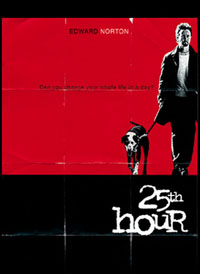 25TH HOUR
25TH HOUR(R)
** (out of 5)
December 19, 2002
STARRING
Edward Norton as MONTY BROGAN
Philip Seymour Hoffman as JAKOB ELINSKY
Barry Pepper as FRANCIS XAVIER SLAUGHTERY
Rosario Dawson as NATURELLE RIVIERA
Anna Paquin as MARY D’ANNUZIO
Brian Cox as JAMES BROGAN
Directed by: Spike Lee
BY KEVIN CARR
In terms of visual imagery and innovative techniques, Spike Lee is clearly one of the masters of filmmaking. In “25th Hour,” his choices of varying film stock, jarring jump cuts and use of depth in the composition of shots is amazing. The friend I was with watching this film said, “I felt like I was actually watching a real movie.” And he’s absolutely right. And to make it even more amazing, Lee’s stunning visuals use only the basic grittiness of New York instead of flashy special effects. It is so refreshing to see this instead of the overstylized (and overused) directing of Michael Bey, who has had way too much influence on modern cinematography.
Now, with that said, I always seem to have a problem with the stories of Spike Lee’s joints. Generally, my biggest complaint is that there is none. With the exception of “Malcolm X” (which was a biopic and had its story pre-packaged), Lee’s films tend to have characters I don’t care about dealing with a situation I even care less about. This trend continues with “25th Hour.”
“25th Hour” tells the story of Monty Brogan (Edward Norton), a man on the verge of going to prison for drug possession. He is to be locked up for seven years, and this is his last chance to enjoy life as a free man. He spends it with his girlfriend Naturalle (Rosario Dawson) and his best friends Jakob (Philip Seymour Hoffman) and Francis (Barry Pepper) sleazing around the city.
The advertising for this film talks about whether someone can change in one day, and that may have made an interesting movie. Too bad we don’t see any changes take place. Sure, Monty contemplates whether he should go to prison or run away, but the character doesn’t change. There’s nothing inherently wrong with a character that doesn’t change. But if the marketing of the film promises that and you’re left with the same pathetic drug dealer at the end of the film as we saw at the beginning, then something is wrong.
Having made a career out of blaming white America for society’s problems, Spike Lee takes a different turn to do a film that isn’t about the black experience. It is refreshing to see Lee break out of his own self-imposed stereotypes to do something a little bit different. In fact, “the man” is actually the black DEA operatives that bust Monty and successfully prosecute him for his crimes.
Of course, there is still plenty of angst saturating the film. In particular, there is a ranting monologue that Monty has in the bathroom in which he blames everyone in New York – from the Pakistani cabbies to the Bensenhurst Italians, and the Korean grocers to the Hassidic Jews – for his problems. Well, he actually doesn’t knock everybody. While he targets one group of black people (the “brothers from uptown”), he noticeably leaves out the folks in Brooklyn. Hmmm. Isn’t Spike Lee from Brooklyn? Wonder why these are the only innocent people in New York City.
While the supporting cast is full of excellent actors, the characters are completely undesirable. One side story that exemplifies the poor construction of supporting characters is that of Jakob, a literature teacher at a local prep school. Played by Philip Seymour Hoffman, Jakob is just another version of Hoffman’s Scotty J. from “Boogie Nights” and Allen from “Happiness.”
Jakob is obsessed with a student named Mary (Anna Paquin). At one point, Mary hooks up with Jakob while he’s ready to go into a club with Monty. She drops some ecstasy and guzzles champagne, and eventually throws herself at Jakob. However, their storyline just fizzles and they disappear from the script completely.
Being a die-hard New Yorker, Lee takes his fair share of potshots at Osama bin Laden and other extreme Islamic terrorists. Even the beginning of the film features a beautifully shot montage of the twin spotlights that fire into the air, replacing the fallen Twin Towers. Of course, this is at times distracting since the World Trade Center and terrorism isn’t featured at all in the story.
In the end, it is as if Lee is simply composing a love letter to New York City and wants to feature this scar. It reminds me of his opening sequence of “Malcolm X” in which he shows the beating of Rodney King superimposed on a burning American flag. Sure, the Rodney King incident was pertinent to the black experience, but it had nothing to do with Malcolm X.
Overall, if you’re a cinematography student, “25th Hour” is a must see. Everyone else, maybe check it out on video. Or don’t.
